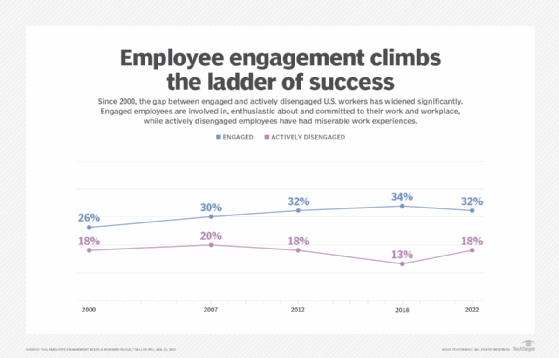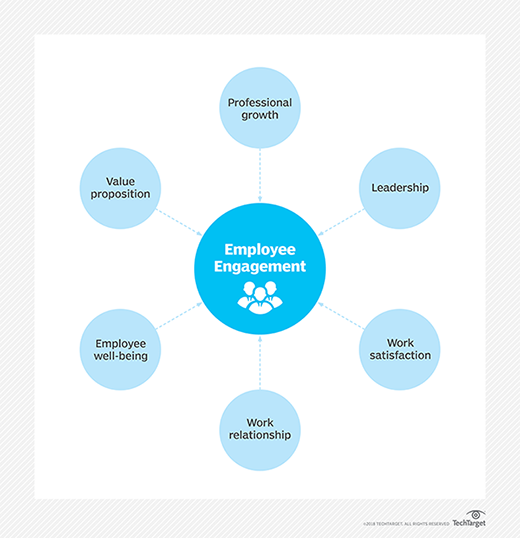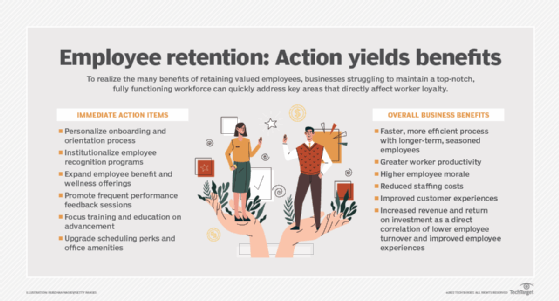employee engagement
What is employee engagement?
Employee engagement is the emotional and professional connection employees feel toward their organization, colleagues and work. High engagement leads to increased job satisfaction, performance, employee retention and is a reflection of a positive overall employee experience.
The meaningfulness of an employee's work is a key factor in engagement, as are their relationships with colleagues and managers, and the support, recognition and development opportunities their organization offers. Truly engaged employees reflect a company's respect for its workforce, which makes it more attractive to prospective hires and can lead to increased profitability and return on investments.
Importance of employee engagement
Organizations with high levels of employee engagement are more profitable and have higher customer satisfaction ratings than ones with low engagement levels, according to Gallup and other researchers. This research also shows that successful engagement efforts lead to less absenteeism and turnover. In a competitive hiring market, engaged staff members who feel they have good work-life balance and high levels of employee satisfaction are also less likely to look elsewhere for employment.
On the flip side, disengaged employees can create a negative atmosphere that can damage a company's reputation, profitability and bottom line. It is critical for organizations to keep employee engagement at a high, positive level.
The recent shift to remote work has made fostering employee engagement even more important. Remote workers can feel isolated and disconnected from colleagues. They also often struggle to maintain a constructive work structure. According to the United States Census Bureau, the number of remote workers tripled between 2019 and 2021. This increase forced organizations to find creative ways to keep remote workers feeling like they're part of a productive, supportive community.

Benefits of employee engagement
Employee engagement programs provide a range of benefits:
- Better business outcomes. Organizations with highly engaged workforces are more profitable, resulting in higher stock prices, shareholder returns and customer satisfaction ratings than organizations with low levels.
- Less turnover. High employee engagement results in less absenteeism, burnout and turnover. In a competitive hiring market, engaged staff members who feel they have good work-life balance and high levels of employee satisfaction are less likely to leave.
- Increased productivity. Engaged employees are more motivated and invested in their work, leading to better performance and increased day-to-day discretionary effort at work.
- Good for employee health. Highly engaged employees often have healthier levels of work-life balance, well-being and physical health.
- Better work culture. Engaged employees often have a positive effect on other co-workers, leading to strong, positive work environments.
- Attractive to top talent. Demonstrable high employee engagement and positive company cultures are attractive to top talent.
- Faster onboarding. A culture of engagement can make onboarding easier, leading to new employees becoming productive faster.
Types of employee engagement
Many activities and initiatives foster employee engagement, such as the following:
- Onboarding. Interactive and compelling human resources onboarding processes explain a company's culture and encourage early camaraderie among new hires.
- Goal setting and rewards. Goal setting offers weekly, monthly or annual goals to boost employee enthusiasm. These programs include employee recognition and rewards for hard work.
- Teamwork. According to experts, having friends at work makes for more engaged employees. Some organizations focus on team-building activities to cultivate a workplace conducive to friendships. Teams encourage individuals to take an active, collaborative role in decision-making, making them feel as if their voice and ideas matter.
- Career development initiatives. Professional development opportunities, company-paid education options and continuous learning are perks that show a company is concerned with employees' development and professional growth.
- Life-work balance. Flexible hours, on-site childcare and other work-life benefits show employees their company understands the life stresses and wants to help.
- Clear communication. Regular and clear communications is an important part of engagement. This involves regular one-on-one check-ins that facilitate employee feedback, transparency and active listening. Short and regular employee surveys known as pulse surveys are also useful communication tools.
- Purpose-driven work. Employees doing work that feels important and purposeful are often more engaged. Not every job serves an overwhelmingly meaningful purpose, but when a company clearly articulates its mission and recognizes hard work, employees feel more appreciated and important.

Technology for engagement
Technology is vital for both fostering and measuring employee engagement. There are several employee engagement tools:
- Employee engagement software solicits employee feedback, sets goals, rewards good performance and collects engagement analytics. Employee engagement software includes survey tools, recognition features, feedback, talent reviews and goals.
- Performance management software aligns work with organizational goals to increase employee productivity. Performance management software is used with workforce analytics to identify groups in need of a greater emphasis on engagement, and set and track more personal employee goals. Employee engagement can also be monitored with social media analytics and sentiment analytics tools.
- Communication and collaboration platforms such as Asana, Microsoft Teams and Zoom, help employees connect with their teams and managers. They provide video conferencing, instant messaging and collaboration capabilities.
- Wellness software provides resources and interactive programs that help employees with stress management and their overall physical and mental health.
How to measure employee engagement
Measuring employee engagement is crucial to maintaining and improving it, especially with large numbers of remote workers. There are several ways to measure employee engagement, including the following:
Employee engagement surveys are a quick way to gather information about what employees are thinking. Different surveys are used to collect different kinds of information. Long-form comprehensive employee surveys are used to get data on a range of topics or take an in-depth look at one topic. Pulse surveys are shorter polls, often related to topical workplace concerns such as transitions. Employee lifecycle surveys are ones done during onboarding and then periodically after and finally when an employee leaves the company. Surveys should be conducted across entire organizations, as well as across groups, teams and individuals. Organizations work with organizational psychologists and data scientists to craft the right questions.
Measurement strategies should identify who is responsible for deciding what areas surveys will target, as well as who takes the lead analyzing the survey results, developing action plans and acting upon these results.
Key performance indicators, or KPIs, are a key part of measuring employee engagement and identifying what needs to be addressed. KPIs include the following metrics:
- Turnover.
- Employee satisfaction index.
- Likelihood to recommend their organization.
- Willingness to perform discretionary efforts at work.
- Absenteeism.
- Intent to stay.
- Sense of accomplishment.
- Internal promotion rate.
- Inclusion.
- Retention.
- Well-being.
Focus groups bring employees together to discuss specific topics. They provide in-depth, real-time feedback.
Informal feedback from regular meetings between managers and employees provides insights into employee engagement and satisfaction.
The following questions can be helpful in assessing employee engagement:
- Do employees arrive early?
- Do clusters of people eat lunch together?
- Are there group outings?
- Can employees come together for community service projects and charity events?
- Are employee turnover rates going down?
- Do employees recommend the company to friends?
How to improve employee engagement
The best way to improve employee engagement is to act upon employee feedback and make changes that address sources of discontent and stress. One way to do this is to identify key drivers of employee engagement and solicit employee feedback on them. Once specific issues are identified, companies should address them. Following up with employees and including them in decision-making is important.
Another approach is fostering an inclusive company culture with good communication. This includes developing and training managers to inspire and engage their employees, and to be emotionally intelligent. Managers should provide meaningful work, recognize employees for hard work and show how that work contributes to the organization's larger goals. Organizations should also offer incentives and programs that show employees the company cares about them, their work-life balance and their health.
How to maintain employee engagement
Employee engagement strategies change over time as the nature of work and workplaces change and new generations of employees join the workforce. For instance, diversity, equity and inclusion concerns are increasingly important to Millennials and Gen-Z employees and company workplaces should strive to reflect that.
Good strategies for implementing and maintaining employment engagement include the following:
- Use employee engagement software to keep an eye on KPIs.
- Encourage open communication among employees, managers and leaders.
- Regularly review and update survey questions to adjust to changing concerns.
- Use feedback and performance metrics to make improvements.
- Offer incentives, such as flexible work arrangements, to promote work-life balance.
- Invest in wellness initiatives such as fitness programs, mental health support, healthy food options in the office and employee assistance programs.
- Use engagement initiatives to create a positive environment that makes employees want to stay with the organization.

Employee engagement is critical to fostering strong employee experience and having satisfied employees. Discover the link between employee experience and customer experience.







